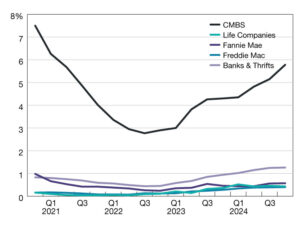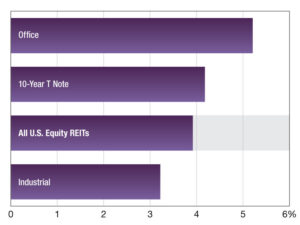Foreign Investment Down, but Not Out


Historically, foreign investors have considered the U.S. a safe haven for commercial real estate investment, but foreign investment in U.S. real estate took a dive in 2024, dropping more than 49 percent year-over-year from nearly $36 billion in 2023 to $26.5 billion in 2024, according to MCSI.
And while most foreign investors take a long view, increasing economic and political tensions leave this year as a question mark for experts.
In 2023 and 2024, cross-border activity represented 6 percent of U.S. investment activity and contributed to the 11 percent growth in transactions in 2024. That was despite increased caution among cross-border capital sources due to rising interest rates, increased macro uncertainty, and such risks as diverging economic growth and the geopolitical landscape, said Lauro Ferroni, head of Americas Capital Markets Research at JLL.
READ ALSO: When Economists Start Using the ‘S’ Word
Total cross-border inflows into U.S. real estate, however, have grown at an average rate of roughly 8.0 percent for more than 20 years, according to Lili Dunn, CEO of Bell Partners, a multifamily asset manager.

A Savills report also attributed the recent decline in cross-border investment to the potential for deglobalization, the strong dollar, decline of the office market, cap rates and economic problems in investors’ own countries.
“The cost of geopolitical tension is high,” stated the report, citing IMF estimates that global GDP losses from geo-economic fragmentation could reach 7 percent—equivalent to the size of the combined economies of the United Kingdom and Japan.
This year, President Trump’s tariffs and threats against allies are causing some investors to look at U.S property investment less favorably, commented Gunnar Branson, CEO of AFIRE.
Historically, foreign investors have been attracted to the U.S. property market’s financial transparency and the nation’s economic and legal stability. “Now that is being questioned, and the political risk is being more closely watched,” Branson said.
Will Canadians ignore the Trump factor?
The top three foreign investors in 2024, in order of investment volume, were Canada, Japan and the United Kingdom, according to MSCI.
Arguably, foreign investment could slow down over the next few years due to a breakdown in relations with top U.S. trading partners, especially Canada, which represented more than one-third of all U.S. foreign investment last year.
However, Bodner contended, Canadian investors, like other global investors, are going to continue to take the long view. He noted that eight major Canadian pension funds, known as the Maple 8, are active in the U.S. property market. “Their mandate is to generate returns and, therefore, (they) will allocate capital to achieve expected benchmarks,” he said. “And given the strong growth in U.S. real estate, our expectation and experience say that’s going to continue.”

There are challenges, but also good opportunities, Branson suggested, pointing out that the nation’s 12 institutional or gateway markets are still compelling for foreign investors. Institutional investors, such as pension funds, are the largest group of foreign investors and will remain committed to the U.S. property market over the long haul.
And while the share of foreign institutional capital allocated to real estate dropped to between 3 percent and 4 percent last year, from the usual 12 percent, according to Branson, these investors focus on large portfolio-type deals.
A recent AFIRE report noted that logistics, data centers and housing all present compelling opportunities for foreign investors due to their growth potential and resilience.
“Industrial market fundamentals remain strong, owing to accelerating tailwinds associated with e-commerce, on- and near-shoring, and a shift from “just-in-time” to “just-in-case” inventory levels,” wrote the authors.
Private real estate debt has also emerged as an attractive option.
Alternative foreign investment pathways
Foreign investors also are investing in private real estate funds. Dunn noted that her company closed an $8.2 billion value-add apartment fund last year that includes capital commitments from foreign investors and acquired three properties over the last six months. Bell Partners also fully deployed a Core Fund last year that includes foreign capital partners.
Another investment pathway for foreign investors is the EB-5 visa, which is managed by the U.S. Citizenship and Immigration Service. This program, which has generated $52 billion in investment since its inception in 1990, provides investors permanent U.S. residency (Green Cards) for the entire family, and a pathway to citizenship for a minimum investment of $800,000 for a targeted employment area and infrastructure or $1 million for other opportunities.

This investment avenue is particularly popular with Asians, noted Reid Thomas, chief strategy officer for Ampersand, which manages EB-5 deposits into Regional Centers, pools of EB-5 capital that invest in commercial enterprises creating at least 10 new jobs.
The program was re-authorized in 2022 for five years, but it is now unclear whether it will survive the current administration. President Trump announced in February that he will replace the EB-5 visa with a “Gold Card” that requires a minimum investment of $5 million. The Gold Card program described by President Trump provides permanent residency for a minimum investment, but it will not fund investment in commercial enterprises nor create jobs, Thomas said.
What’s to like about the U.S. property market
Foreign investors have a strong appetite for U.S. real estate across the board because investors can count on the nation’s strong rule of law, clear ownership and guidelines, said Tim Bodner, partner & deals leader for PwC’s Global & U.S. Real Estate Practice.
Scale, liquidity, transparency, and diversification benefits have also fueled demand from overseas investors, Dunn said.
Foreign investors also are attracted to the multitude of U.S. property sectors and geographic diversification that span gateway and “momentum” markets across the Sun Belt. “The ability to acquire assets at reset valuations compared to the 2021 market peak also is a driver,” Dunn said.
Currently, there is a big presence of foreign capital in New York City, Boston, San Francisco, Dallas, Houston and Miami, Bodner said. And outside of the gateway cities, there is activity in Sun Belt markets, such as Nashville, Atlanta and Phoenix.
Moving forward, geopolitical matters will be top of mind for global real estate investors when assessing relative risk-return requirements.
“Adjustments in pre-existing relationships are causing new investment opportunities to arise, and so I think you can look at it on both sides of the coin, and that’s what we see,” Bodner said.

Trump’s use of tariffs to increase U.S. manufacturing production may force foreign companies with a significant U.S. customer base to invest in production facilities in America, Bodner suggested,
JLL’s 2024-2025 Industrial Tenant Study found that the share of manufacturing requirements jumped to 18.8 percent of current tenant demand—up from 13 percent in 2023, Ferroni noted.
Dunn also believes the new administration’s fiscal, trade, immigration, climate and energy policies will bring both opportunities and challenges for investment flows. While tax cuts and deregulation could stimulate job and household growth, they could also re-ignite inflation and, combined with lower immigration, impact economic growth, household formations, and apartment demand.
Bell Partners expects multifamily to be a favored asset class among foreign investors over the near and long term. “We believe apartments are well-positioned to withstand this period of broader economic uncertainty and volatility given relatively healthy fundamentals,” Dunn said.
There is no consensus on how a trade war and geopolitical tensions will impact the flow of foreign investment. “It’s too early to say, but it initiated hesitancy and fear of what could happen, and what could happen is alarming,” Branson said.
“And while caution is warranted, well-capitalized buyers with longer-term hold periods can secure attractive investment opportunities during the current period of inflection and uncertainty,” she added.
Canadian investors are sorting through the noise and are concerned, Branson suggested. Pension funds are beholden to their constituents, and the economic pain of a trade war, along with rhetoric about annexing Canada as the 51st state, continue to decimate goodwill with Canadians and could potentially impact their U.S. investments.
However, he believes that U.S. real estate will remain compelling for foreign pension funds, which he contended are less concerned by what is happening right now than where things are going over the next 10 years.
With tariffs pending …
In the near-term, however, the outlook for foreign investment remains highly uncertain, said Darin Mellott, CBRE head of U.S. Capital Markets Research.
“We continue to monitor potential changes in policy, which are particularly difficult to predict, and have revised down our growth forecast and increased our inflation expectations, given the evolving stance of the Administration with regard to trade,” he added.
CBRE’s latest preliminary “house view,” Mellot said, anticipates U.S. growth to be slightly below 2 percent, with a partial recovery expected in 2026 and 2027, and projects the headline CPI to be around 2.8 percent.
The post Foreign Investment Down, but Not Out appeared first on Commercial Property Executive.




